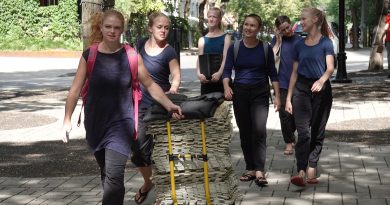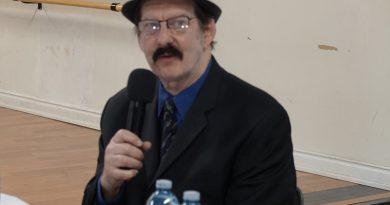A Moment of Gratitude: Looking Back with Mindful Appreciation
Markham, ON — October 11, 2025—Shaoren Gou, World Chinese Media –Venerable Zhaoxu, Abbot of the Chinese Buddhist Temple and President of the Buddhist Federation of Canada, presided over the meeting. With calm composure, he opened by saying,
“Today’s gathering is one of gratitude — a chance to look back with appreciation. I sincerely thank all the abbots, professors, and Dharma friends who took part in the Fourth U.S.–China–Canada Buddhist Forum. Because of your collective efforts, the event was brought to a perfect completion.”
Originally planned for the Mid-Autumn Festival, the gathering was postponed due to busy temple schedules — yet, as the Abbot noted, “It seems this timing is just right, as if guided by Dharma.”
He reflected on the significance of the New York forum:
“Our active participation not only earned recognition from both the U.S. and Chinese Buddhist communities but also marked a new milestone for Canadian Buddhism. It was not only an event of success, but also one of awakening — a call for unity and purpose.”
Venerable Zhaoxu explained that while the Buddhist Federation of Canada has been established for over a decade, its collective activities had mostly arisen in times of crisis or humanitarian need. “Now,” he said, “through this tri-national collaboration, Canadian Buddhism is stepping forward with renewed purpose — to bring compassion and wisdom to our society, to help restore balance and harmony in people’s hearts.”
“Peace in the world begins with peace in the heart,” he continued. “When we cultivate compassion and act with wisdom, stability naturally arises — within ourselves, within communities, and within society.”
His voice carried warmth and strength — like a temple bell resonating through the autumn air.


Academic Vision: The Humanistic Path in North America
During the discussion, Dr. Yi Jizhang, Dean of the Institute of Humanistic Buddhist Thought and Practice at Trinity College, University of Toronto, spoke about new developments in integrating Humanistic Buddhism into North American academia.
He explained that the Institute focuses not only on scholarship but also on practice — striving to establish meaningful dialogue between Buddhist thought and Western philosophy and theology.
“We are currently developing a master’s degree program in Humanistic Buddhism,” Dr. Yi said. “Our goal is to train future Buddhist leaders who embody both intellectual depth and spiritual cultivation. The model draws inspiration from North America’s established seminary system for Christian ministers — an approach that combines knowledge, ethics, and practice.”
He emphasized that Humanistic Buddhism is not confined to monasteries or texts but is a living wisdom — a spiritual light that can illuminate the modern world.
His remarks revealed a hopeful vision: a synthesis of East and West, faith and reason, tradition and innovation.

Art and Awakening: From Nature to Inner Peace
Michael Janzen, President of the International Federation of Arts and Artists and a renowned Canadian artist, was unable to attend the New York forum due to wrist surgery. Nevertheless, his paper, Advancing Peace by Ways of Creativity, was included in the official proceedings of the Fourth U.S.–China–Canada Buddhist Forum, earning wide appreciation for its depth and insight.
At today’s gathering in Markham, Michael shared a heartfelt reflection on his lifelong search for peace through art and nature. Speaking with warmth and sincerity, he said:
“Since childhood, I have sought peace through art and nature. When I gazed upon ancient Chinese art, a deep serenity arose within me — it was my first experience of meditative stillness. Peace is not far away; it lives in the present moment. Art is my way of meditation — my path to peace.”
His words moved the audience to silence. Some bowed gently; others smiled softly. In that quiet moment, art and Dharma met — two languages of beauty, both leading to the same awakening.
Michael’s reflections bridged creativity and contemplation, showing how artistic creation can become a form of spiritual practice. As he wrote in his paper,
“Every human being can awaken to the fact that we are all powerful creative beings… creative freedom brings us closest to who we truly are.”
For him, creativity is not only expression — it is transformation, and ultimately, peace itself.

From New York to Toronto: A Continuation of Dharma Joy
The Fourth U.S.–China–Canada Buddhist Forum was held from September 11–12, 2025, at Columbia University’s Conference Center in New York under the theme “Hearts Toward Peace, Shaping the Future Together.”
More than 300 delegates from the three nations — including representatives of Chinese, American, and Canadian Buddhist associations — gathered to explore Buddhism’s role in promoting cultural understanding and world peace.
The opening ceremony was attended by Venerable Yanjue, President of the Buddhist Association of China; Venerable Mingyu, President of the American Buddhist Confederation; and Venerable Zhaoxu, President of the Buddhist Federation of Canada.

New York Mayor Eric Adams presented an official commendation, praising the forum’s contribution to global harmony and interfaith dialogue. The event included a World Peace Prayer Ceremony and two sub-forums on Buddhist Text Digitalization and Buddhism and Social Harmony. Delegates also visited temples across New York and New Jersey, strengthening ties of friendship and Dharma exchange.
As Venerable Zhaoxu said during today’s meeting,
“From New York to Toronto, from sharing joy to planning the future, we shall continue to sail with compassion as our vessel and wisdom as our sail — letting the light of the Dharma shine upon the world.”





Looking Ahead: The Fifth Forum and the Blossoming of Peace
Toward the end of the gathering, the discussion turned to the future:
the Fifth U.S.–China–Canada Buddhist Forum will be hosted by the Buddhist Federation of Canada in Toronto in 2027.
This decision marks not only a continuation of tradition but also a new beginning. “We hope this will not just be a conference,” said Venerable Zhaoxu, “but a journey of inner communication and collective awakening. May the wisdom and compassion of Buddhism flow from the ancient temples of the East to the vibrant cities of North America — from sacred texts into everyday lives.”
Preliminary plans envision an event combining academic forums, artistic exhibitions, and meditation retreats, reflecting Buddhism’s multidimensional presence in contemporary society. Monastics and scholars from Asia, North America, and Europe will be invited to explore how Buddhist wisdom can address the spiritual challenges of modern life and guide humanity toward peace and compassion.
“We look forward to hearing once again the harmonious sound of joined palms — a global resonance of the human heart,”
the Abbot concluded with a smile.
Epilogue: May the Lamp of Peace Illuminate the World
As twilight settled, the temple’s lanterns glowed softly in the cool October air. Nearly thirty participants — including Venerables Zhaoguang, Zhite, Xuewen, Lianding, Miaowu, Ruan, and Shengmiao, along with volunteer leader Zhou Shufang and Miaoyun — gathered in warmth and laughter to close the evening in gratitude.
On the table, fragrant tea and mooncakes evoked lingering Mid-Autumn sentiments. One mooncake, carried all the way from the U.S. by a Dharma friend and returned to Toronto through the Abbot’s hands, became a symbol of transnational friendship — a “gift of karma” linking hearts across oceans.
Under the quiet moonlight, the temple eaves shimmered like silver.
Some said that at that moment, the moonlight and the Dharma light became one —
and peace, no longer a distant ideal,
became a gentle yet steadfast force,
already taking root in Canadian soil.




